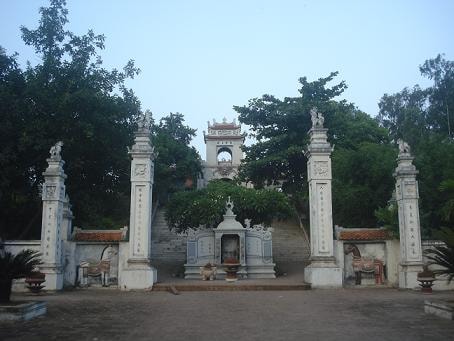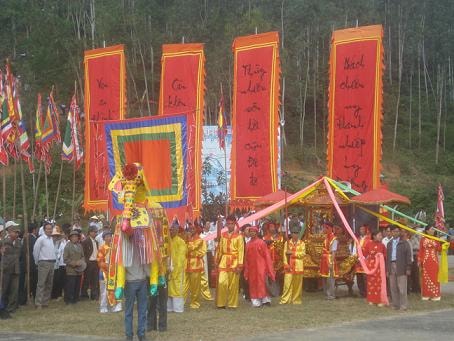Lesson 3: The end of the Au Lac period and Mai Thuc Loan's uprising
(Baonghean) -This is a period that left a strong mark in the country's history regarding the indomitable spirit and resilience of our people against the Northern feudal domination for more than a thousand years. The historical and cultural relics of this period contributed to recording that mark.
From Cuong Temple sediments
In 257 BC, Thuc Phan, the leader of the Au Viet people in the North of Van Lang, defeated the 18th Hung King of the Lac Viet people, merged Van Lang into his territory and became Au Lac, proclaimed himself An Duong Vuong, and established the capital in Co Loa (Dong Anh - Hanoi). In 179 BC, Trieu Da led his army to invade our country. According to legend, after many unsuccessful attacks, Trieu Da had to make peace and then plotted to marry An Duong Vuong's daughter, My Chau, to his son, Trong Thuy, with the plot to let Trong Thuy live with him and then find a way to steal the "magic crossbow", thereby defeating the Au Lac army. The ending of the legend took place on Mo Da mountain, Cao Xa commune, Dien Chau prefecture (now Dien An commune, Dien Chau district).
The Thuc dynasty opened in Co Loa and closed in Nghe An from 275 BC - 208 BC. Although it failed, Thuc An Duong Vuong expanded the territory, promoted the will of independence, heroic spirit, and strategic talent to defeat the Qin army, so he was respected by the people. To remember his contributions, one of the kings of our country in the early days of the country's founding, in addition to his temple in Co Loa, people also worship him at Cuong temple - a temple halfway up Mo Da mountain, a mountain of Dai Hai range, the last mountain range of a branch on the Truong Son range.

Temple of King An Duong Vuong
Cuong Temple is a historical relic ranked by the State and is also a famous place that anyone who has visited will find hard to forget because of the harmonious combination of architecture and natural scenery. The structures are massive and solid but exude a gentle, sacred beauty thanks to the delicately carved details. The mountains of Dai Hai range and the rocks all contain the legend of Thuc An Duong Vuong. The chessboard rock is where Thuc An Duong Vuong sat to play chess with the Kim Quy God from the sea. In addition, there are Kiem mountain, Dau Can mountain in Nghi Thiet commune (Nghi Loc), Mu mountain (Mu mountain) in Dien Phu commune, Ma Yen mountain (Yen Ngua) in Dien Tho commune (Dien Chau)... each mountain bears the name of an object on Thuc An Duong Vuong's body. Not far from Cuong Temple, there is a small temple worshiping Princess My Chau. In Nghe An, there are also some other relics related to Thuc An Duong Vuong, such as the Dragon Pagoda relic in Quy Chau, which is said to be the place to worship the son of Thuc An Duong Vuong. In addition, there is also the Cao family temple and Xuan Ai communal house in Dien Tho...
Before the August Revolution in 1945, every year at Cuong Temple, there was a great ceremony called International on the 15th day of the 2nd lunar month, instead of a festival like in Co Loa. During the years of resistance, the temple was destroyed and damaged, so many ritual activities were somewhat limited.
To the tomb of King Mai
After conquering Au Lac, Trieu Da divided our country into 2 districts to rule. During the long night of Chinese domination, the people suffered a lot. Many uprisings broke out during this period. At the beginning of the 8th century, from the land of Hoan Chau (Nghe An today), a great uprising broke out - Mai Thuc Loan's uprising.

The Mai King Festival is held every January.
Mai Thuc Loan was born in Ngoc Trung hamlet, near Ru De (Nam Dan district). Understanding the suffering of the people who lost their country and hating the invaders, he mobilized the people to rise up against the Tang Dynasty in April of the year Quy Suu 713. In 722, after failing in the sudden, massive siege of the Tang Dynasty general Duong Tu Huc, Mai Thuc Loan was seriously injured and died at Dun Son mountain, ending 10 years of uprising. This was the most typical uprising for the patriotism of the people of Nghe An. After this uprising, the Tang Dynasty had to abandon the tribute payment system and change some policies to govern our people.
When Mai Thuc Loan died, the people built a tomb at Dun Son mountain, the base of the insurgents and the place where he breathed his last (now in Van Dien commune), Nam Dan district. When Mai King Temple was first built, it was only a small temple with simple architecture. It was not until the second year of Minh Mang (1812) that it was built large, beautiful and majestic. Currently, after many restorations and embellishments, although it is not as majestic and imposing as before, what exists in the temple has shown the gratitude and admiration of later generations for Mai Thuc Loan.
From the Mai King Temple, visitors follow dike 42 or cruise along the left bank of the Lam River about 3km to the West to reach the Mai King tomb located in the middle of a narrow valley, at the foot of Dun Son Mountain. According to legend, this is where the remains of Mai King and his son, Mai Thuc Huy, are kept. After the war, since 1997, and especially in recent years, Mai King's tomb has been meticulously restored and embellished, majestically commensurate with the name and position of the national hero.
There is an interesting thing that scattered around the King Mai temple, within a radius of less than 4km, there are many relics and places that have been associated with the name and achievements of King Mai, forming a unique relic complex, with many advantages in terms of exploiting tourism potential such as his, the tomb of King Mai's mother located on Gie mountain (Nam Thai commune), Nam Son Thuong Tuong temple - the place to worship the general in the four pillars of the court of King Mai (Van Dien commune), Ngoc Dai Son - the place where the command headquarters of all the naval and land forces of King Mai's insurgent army is located (Van Dien commune), Voi Mountain - where the Tang army set up headquarters and organized attacks on Van An citadel (Nam Tan commune). Currently, these relics have been preserved and maintained by Nam Dan district for promotion.
1. In the Spring of the Year of the Rooster (1993), Dien Chau district decided to take the 15th day of the 2nd lunar month as the date to hold the annual Cuong Temple Festival. After many times of restoration and embellishment, in 2004, the Ministry of Culture, Sports and Tourism agreed with the Provincial People's Committee's policy on establishing a project to preserve and embellish the Cuong Temple relic. In 2005, the Cuong Temple relic project was started. In 2006, the main items were completed such as: preserving, embellishing and upgrading the Cuong Temple; building the office building of the relic management board, parking system, upgrading and expanding the festival yard. Currently, the district is having a project to restore My Chau temple and Trong Thuy well (destroyed during the war) with a total area of about 2000m2, planning to build more Than island, Kim Quy tower, expand the area of the side yard to make a camping ground during the festival... |
Thanh Thuy - Thanh Le






